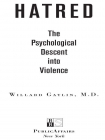Hatred, Willard Gaylin [best ebook for manga txt] 📗

- Author: Willard Gaylin
Book online «Hatred, Willard Gaylin [best ebook for manga txt] 📗». Author Willard Gaylin
No real attempt at a scientific understanding of sickness, physical or mental, would emerge until the latter half of the nineteenth century. With a stunning burst of creativity, modern medicine was born in the research laboratories of Europe by such distinguished scientists as Pasteur, Koch, Ehrlich, Semmelweis, Wundt, Helmholtz, and Virchow. We began to understand the nature of physical illness and were on our way to discovering the cures.
Still, there was no concept of anything called mental disease, that is, disease of the mind, as distinguished from disease of the brain. Insanity was conceptualized in the same way as one viewed heart disease: as being a product of organ damage or system deterioration. And at that time this view was adequate. Most of the mental conditions that were recognized in the nineteenth century were actually the result of brain damage, a product of stroke, degenerative senile changes, or the damage wrought on the brain by late-stage syphilis, the leading cause of admission to insane asylums. It was easy then to view mental illness as brain disease. If liver functions failed, the liver was damaged. If thinking was disordered, there must be brain damage.
The body itself was envisioned in the same terms as other physical structures, a collapsing roof or a leaky cistern. Sickness was the product of wear and tear of age, a traumatic injury, or an invasive organism, such as the newly discovered bacteria. Since behavior was perceived as a product of the brain and peripheral nervous system, mental illnesses were called “nervous disorders,” and the physician looked for physical malfunctions in the nervous system to repair. In those early days, the behavioral abnormalities that concerned medicine and the courts were those at the extreme periphery of human conduct, those that would be described by laymen as crazy, lunatic, or insane. They were what we today would call the major psychoses. All that would change with the revolutionary work of Sigmund Freud at the beginning of the twentieth century.
Freud, a neurologist, was attracted to a series of conditions called “the hysterias.” Hysteria is not to be confused with the current usage of the word “hysteria” as in “acting hysterical,” that is, being overemotional. Hysteria, as it was understood in the nineteenth century, was an illness characterized by a physical symptom that had no demonstrable physical damage to the affected organ: for example, blindness with no damage to the structure of the eye or the optic nerve. Or more curiously, a symptom that could not possibly be explained anatomically. Such a condition was glove anesthesia; a patient would exhibit a hand numb from the wrist down. This is an actual impossibility, since the sensory nerves run in a linear track from the armpit to the finger, not in annular circles around the hand. Nerve damage would cause anesthesia in a line down the arm and into the thumb, let’s say, sparing the other fingers.
After years of investigation, Freud came to the startling conclusion that these “neuroses,” as they were called—literally nervous inflammations—had nothing to do with the status of nerve fibers but were products of psychological conflicts and the stress that they produced. This conclusion was a monumental departure from the prevailing medical model of disease formation. Freud dared to suggest that feelings and ideas as well as poisons, trauma, or invading organisms could cause disease. His audacious statement that “the hysteric suffers from reminiscences” infuriated a medical community that had finally achieved scientific legitimacy by locating the physical causes of disease in damaged organs. Freud was now saying that for certain diseases the causes were not physical and the organs remained undamaged. He paid in ridicule and censure.
Freud honored mental illness by applying to it the same rigorous standards of study that were then being applied to the burgeoning understanding of physical disease. He not only discovered the tools for understanding the human condition, but he applied those tools to the newly created field of mental illness. He created the equivalent of a physiology of mental illness. By that I mean that he carefully tracked the normal internal mental processes—the physiology of the mind, and looked for the distortions, the pathology, that lead to mental illness.
In the days before the discovery of the germ theory, diseases were labeled according to their symptoms. Patients suffered from fevers, agues, and chills. What was then described as the illness was often the visible manifestation of the body’s defense against the illness—the symptoms. A fever is an elevation of body temperature designed to enhance the chemical reactions brought into play to fight the offending organism—not yet identified. As any cook knows, heating increases the rate of chemical responses. The body “knows” this automatically.
The inflamed and ugly boil marks the entrance of a toxin, foreign body, or bacterial agent disturbing the integrity of a bodily tissue or function. The body responds to the attack with an immune response. It rushes white cells to the spot, increases the vascularity in the area to facilitate the delivery of blood elements that fight the invader, and ratchets up the heat to speed the chemical responses. A boil, when examined, is therefore red, hot, inflamed, and filled with pus. None of these is the “disease”—a staphylococcus infection—but a sign of the





Comments (0)